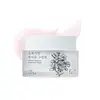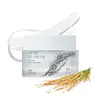What's inside
What's inside
 Key Ingredients
Key Ingredients

 Benefits
Benefits

 Concerns
Concerns

 Ingredients Side-by-side
Ingredients Side-by-side

Water
Skin ConditioningButylene Glycol
HumectantPhenyl Trimethicone
Skin ConditioningGlycerin
Humectant1,2-Hexanediol
Skin ConditioningAmmonium Acryloyldimethyltaurate/Vp Copolymer
Glucose
HumectantCarbomer
Emulsion StabilisingChlorella Vulgaris Extract
Skin ConditioningTromethamine
BufferingCaprylyl Glycol
EmollientFructose
HumectantFructooligosaccharides
HumectantSodium Hyaluronate
HumectantDipotassium Glycyrrhizate
HumectantOryza Sativa Extract
AbsorbentDisodium EDTA
Citrus Aurantium Bergamia Fruit Oil
MaskingEthylhexylglycerin
Skin ConditioningLavandula Angustifolia Oil
MaskingCyanocobalamin
Skin ConditioningPrunus Persica Flower Extract
MoisturisingLilium Candidum Flower Extract
Skin ConditioningPrunus Persica Fruit Extract
AbrasiveMethylpropanediol
SolventPaeonia Albiflora Root Extract
Skin ConditioningMagnolia Liliflora Flower Extract
Skin ConditioningBifida Ferment Extract
HumectantWater, Butylene Glycol, Phenyl Trimethicone, Glycerin, 1,2-Hexanediol, Ammonium Acryloyldimethyltaurate/Vp Copolymer, Glucose, Carbomer, Chlorella Vulgaris Extract, Tromethamine, Caprylyl Glycol, Fructose, Fructooligosaccharides, Sodium Hyaluronate, Dipotassium Glycyrrhizate, Oryza Sativa Extract, Disodium EDTA, Citrus Aurantium Bergamia Fruit Oil, Ethylhexylglycerin, Lavandula Angustifolia Oil, Cyanocobalamin, Prunus Persica Flower Extract, Lilium Candidum Flower Extract, Prunus Persica Fruit Extract, Methylpropanediol, Paeonia Albiflora Root Extract, Magnolia Liliflora Flower Extract, Bifida Ferment Extract
Water
Skin ConditioningButylene Glycol
HumectantCaprylic/Capric Triglyceride
MaskingGlycerin
HumectantLimnanthes Alba Seed Oil
Skin ConditioningCetearyl Alcohol
Emollient1,2-Hexanediol
Skin ConditioningPentylene Glycol
Skin ConditioningVinyl Dimethicone
Polyglyceryl-3 Methylglucose Distearate
EmulsifyingCetearyl Olivate
Sorbitan Olivate
EmulsifyingHydroxyethyl Acrylate/Sodium Acryloyldimethyl Taurate Copolymer
Emulsion StabilisingGlucose
HumectantChlorella Vulgaris Extract
Skin ConditioningSodium Polyacryloyldimethyl Taurate
Emulsion StabilisingFructose
HumectantFructooligosaccharides
HumectantHydrogenated Polydecene
EmollientSodium Hyaluronate
HumectantEthylhexylglycerin
Skin ConditioningOryza Sativa Extract
AbsorbentXanthan Gum
EmulsifyingSorbitan Isostearate
EmulsifyingTrisodium Ethylenediamine Disuccinate
Trideceth-10
CleansingHydrolyzed Corn Starch
HumectantSucrose
HumectantCitrus Aurantium Bergamia Fruit Oil
MaskingOryza Sativa Bran Extract
Skin ConditioningPhaseolus Radiatus Seed Extract
Skin ConditioningTocopherol
AntioxidantPhaseolus Radiatus Extract
Skin ConditioningSea Salt
AbrasiveAspergillus Ferment
Skin ConditioningTriticum Vulgare Sprout Extract
Skin ConditioningOryza Sativa Germ Extract
EmollientSesamum Indicum Sprout Extract
HumectantGlycine Soja Sprout Extract
EmollientPhaseolus Radiatus Sprout Extract
HumectantBetula Platyphylla Japonica Bark Extract
Skin ConditioningRumex Crispus Root Extract
Skin ConditioningWater, Butylene Glycol, Caprylic/Capric Triglyceride, Glycerin, Limnanthes Alba Seed Oil, Cetearyl Alcohol, 1,2-Hexanediol, Pentylene Glycol, Vinyl Dimethicone, Polyglyceryl-3 Methylglucose Distearate, Cetearyl Olivate, Sorbitan Olivate, Hydroxyethyl Acrylate/Sodium Acryloyldimethyl Taurate Copolymer, Glucose, Chlorella Vulgaris Extract, Sodium Polyacryloyldimethyl Taurate, Fructose, Fructooligosaccharides, Hydrogenated Polydecene, Sodium Hyaluronate, Ethylhexylglycerin, Oryza Sativa Extract, Xanthan Gum, Sorbitan Isostearate, Trisodium Ethylenediamine Disuccinate, Trideceth-10, Hydrolyzed Corn Starch, Sucrose, Citrus Aurantium Bergamia Fruit Oil, Oryza Sativa Bran Extract, Phaseolus Radiatus Seed Extract, Tocopherol, Phaseolus Radiatus Extract, Sea Salt, Aspergillus Ferment, Triticum Vulgare Sprout Extract, Oryza Sativa Germ Extract, Sesamum Indicum Sprout Extract, Glycine Soja Sprout Extract, Phaseolus Radiatus Sprout Extract, Betula Platyphylla Japonica Bark Extract, Rumex Crispus Root Extract
Ingredients Explained
These ingredients are found in both products.
Ingredients higher up in an ingredient list are typically present in a larger amount.
1,2-Hexanediol is a synthetic liquid and another multi-functional powerhouse.
It is a:
- Humectant, drawing moisture into the skin
- Emollient, helping to soften skin
- Solvent, dispersing and stabilizing formulas
- Preservative booster, enhancing the antimicrobial activity of other preservatives
Butylene Glycol (or BG) is used within cosmetic products for a few different reasons:
Overall, Butylene Glycol is a safe and well-rounded ingredient that works well with other ingredients.
Though this ingredient works well with most skin types, some people with sensitive skin may experience a reaction such as allergic rashes, closed comedones, or itchiness.
Learn more about Butylene GlycolChlorella Vulgaris Extract comes from a green microalga. It is hydrating and contains antioxidants.
Studies also show Chlorella Vulgaris may help in rebuilding collagen and elastin. This ingredient is made up of lipids, carbohydrates, and chlorophyll.
Fun fact: This ingredient is commonly used as food additive in Japan.
Learn more about Chlorella Vulgaris ExtractCitrus Aurantium Bergamia Fruit Oil is the oil from the bergamot orange. It is native to Italy.
This ingredient is used to add fragrance to products. It contains limonene, linalool, and linalyl acetate.
The term 'fragrance' is not regulated in many countries. In many cases, it is up to the brand to define this term. For instance, many brands choose to label themselves as "fragrance-free" because they are not using synthetic fragrances. However, their products may still contain ingredients such as essential oils that are considered a fragrance.
When used topically, Citrus Aurantium Bergamia Fruit Oil is a photosensitizer due to its furanocoumarins. Photosensitizers make the skin and eyes much more sensitive to sunlight. Photosensitizers are linked to skin cancer.
However, more cosmetics using Citrus Aurantium Bergamia Fruit Oil are removing the furanocoumarins.
Bergamot oil was also found to have anti-inflammatory, antibacterial and antifungal properties.
Learn more about Citrus Aurantium Bergamia Fruit OilEthylhexylglycerin (we can't pronounce this either) is commonly used as a preservative and skin softener. It is derived from glyceryl.
You might see Ethylhexylglycerin often paired with other preservatives such as phenoxyethanol. Ethylhexylglycerin has been found to increase the effectiveness of these other preservatives.
Fructooligosaccharides is an alternative sweetener. It is often derived from the blue agave plant.
This ingredient is a prebiotic and helps to hydrate the skin. Emerging studies are also showing fructooligosaccharides to have antioxidant properties.
As a humectant, Fructooligosaccharides helps draw moisture to the skin, helping to hydrate the skin.
Bananas, onions, garlic, asparagus, jícama, and leeks also contain fructooligosaccharides.
Learn more about FructooligosaccharidesGlucose is a simple sugar and is the most important source of energy in all organisms.
In skincare, glucose is used to hydrate the skin. It also acts as a prebiotic for our natural biome.
Glucose is hydrating due to its humectant property. As a humectant, glucose draws moisture from the air and from deeper levels in the skin.
Our skin contains many sugars that act as prebiotics and help strengthen our natural microbiome. Having a healthy microbiome helps protect our skin from harmful bacteria and other contaminants.
Studies show glucose may help with fading discoloration and pigmentation. This is because our skin metabolizes glucose into lactic acid. Lactic acid is an AHA that helps exfoliate the top layer of skin.
Learn more about GlucoseGlycerin is already naturally found in your skin. It helps moisturize and protect your skin.
A study from 2016 found glycerin to be more effective as a humectant than AHAs and hyaluronic acid.
As a humectant, it helps the skin stay hydrated by pulling moisture to your skin. The low molecular weight of glycerin allows it to pull moisture into the deeper layers of your skin.
Hydrated skin improves your skin barrier; Your skin barrier helps protect against irritants and bacteria.
Glycerin has also been found to have antimicrobial and antiviral properties. Due to these properties, glycerin is often used in wound and burn treatments.
In cosmetics, glycerin is usually derived from plants such as soybean or palm. However, it can also be sourced from animals, such as tallow or animal fat.
This ingredient is organic, colorless, odorless, and non-toxic.
Glycerin is the name for this ingredient in American English. British English uses Glycerol/Glycerine.
Learn more about GlycerinOryza Sativa Extract comes from the rice grain, Oryza sativa. Rice extract has wound healing, antioxidant, anti-inflammatory, and hydrating properties.
Rice grains contain numerous antioxidants which may help with anti-aging, such as vitamin E. Antioxidants help stabilize free-radical molecules. Unstable free-radical molecules may damage your skin cells and accelerate signs of aging.
A study from 2002 found rice to help increase the rate of wound healing. The same study found an improvement of skin barrier function in the patients after taking rice baths.
Numerous in-vitro studies have found rice water to help decrease sun damage by increasing collagen production and inhibiting the process of tyrosinase.
Long story short- tyrosinase is an enzyme that controls melanin production. Our bodies start producing melanin (AKA tanning) when exposed to UV radiation to protect against damage. Rice water is found to partially block this process.
Though more research is needed on rice's ability to help with UV protection, recent studies seem promising.
Wondering why rice is hydrating? The protein in rice have emollient properties. Emollients create a barrier on the skin to trap moisture in, keeping your skin moisturized.
Some rice extract may have mildly-exfoliating properties. These are mainly limited to Oryza Sativa (Rice) Bran and Oryza Sativa (Rice) Germ Powder.
This rice was first cultivated in China over 10,000 years ago. Many cultures throughout Asia have used rice water on skin and hair for centuries.
Learn more about Oryza Sativa ExtractSodium Hyaluronate is hyaluronic acid's salt form. It is commonly derived from the sodium salt of hyaluronic acid.
Like hyaluronic acid, it is great at holding water and acts as a humectant. This makes it a great skin hydrating ingredient.
Sodium Hyaluronate is naturally occurring in our bodies and is mostly found in eye fluid and joints.
These are some other common types of Hyaluronic Acid:
Learn more about Sodium HyaluronateWater. It's the most common cosmetic ingredient of all. You'll usually see it at the top of ingredient lists, meaning that it makes up the largest part of the product.
So why is it so popular? Water most often acts as a solvent - this means that it helps dissolve other ingredients into the formulation.
You'll also recognize water as that liquid we all need to stay alive. If you see this, drink a glass of water. Stay hydrated!
Learn more about Water